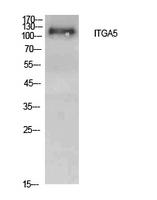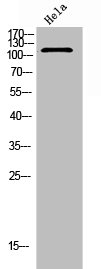Mouse anti Integrin alpha 5 (CD49e)
MUB0910P
ApplicationsFlow Cytometry, ImmunoPrecipitation, ImmunoCytoChemistry, ImmunoHistoChemistry, ImmunoHistoChemistry Frozen
Product group Antibodies
ReactivityHuman, Primate
TargetITGA5
Overview
- SupplierNordic-MUbio
- Product NameMouse anti Integrin alpha 5 (CD49e)
- Delivery Days Customer7
- Application Supplier NoteNKI-SAM-1 is suitable for flow cytometry (recommended range is 1:200 - 1:500, using 0.2-0.5 microg for 10^6 cells) and can be used to determine the VLA-5 expression in peripheral blood monocytes and monocyte derived dendritic cells (see refs 2 and 3), B cells and B-cell precursors (ref. 4), and in the less pathogenic yeast Candida species (ref. 5). NKI-SAM-1 can also be applied in immunohisto-chemistry on frozen tissues, immunocytochemistry and immunoprecipitation. Optimal antibody dilution should be determined by titration.
- ApplicationsFlow Cytometry, ImmunoPrecipitation, ImmunoCytoChemistry, ImmunoHistoChemistry, ImmunoHistoChemistry Frozen
- Applications SupplierFlow Cytometry;Immunohistochemistry (frozen);Immunoprecipitation;Immunocytochemistry
- CertificationResearch Use Only
- ClonalityMonoclonal
- Clone IDNKI-SAM-1
- Gene ID3678
- Target nameITGA5
- Target descriptionintegrin subunit alpha 5
- Target synonymsCD49e, FNRA, VLA-5, VLA5A, integrin alpha-5, CD49 antigen-like family member E, ITGA5/SLC9B1 fusion, fibronectin receptor subunit alpha, fibronectin receptor, alpha polypeptide, fibronectin receptor, alpha subunit, integrin alpha-F, integrin, alpha 5 (fibronectin receptor, alpha polypeptide), very late activation protein 5, alpha subunit
- HostMouse
- IsotypeIgG2b
- Protein IDP08648
- Protein NameIntegrin alpha-5
- SourceNKI-SAM-1 is a monoclonal antibody obtained by fusion of mouse myeloma cells with spleen cells from BALB/C mice immunized with U937 histiocytic lymphoma cells.
- ReactivityHuman, Primate
- Reactivity SupplierHuman;macaque
- UNSPSC12352203






